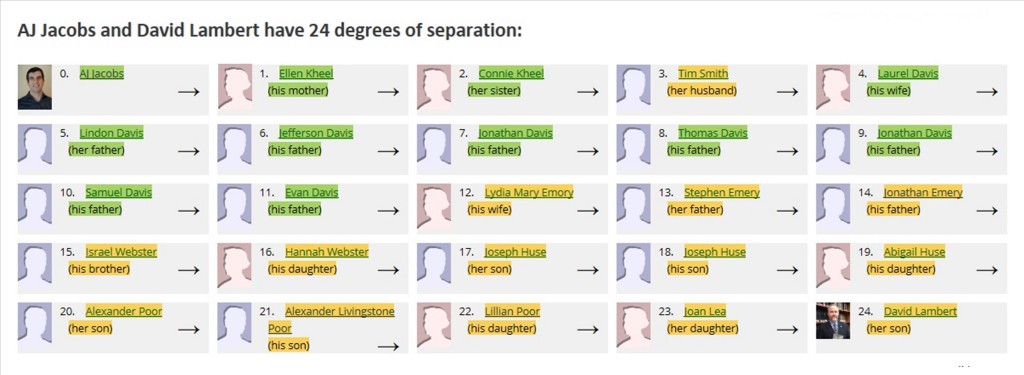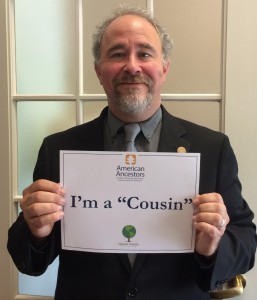 Thousands are expected to gather on Saturday, June 6, at the New York Hall of Science in Flushing Meadows, Queens, for the very first Global Family Reunion – founded by bestselling author A.J. Jacobs – who describes himself as “father of three, the husband of one, and the cousin to millions.” Expected to be the biggest, most extraordinary, and most inclusive family reunion in history, the world of genealogy is indeed watching this one and smiling.
Thousands are expected to gather on Saturday, June 6, at the New York Hall of Science in Flushing Meadows, Queens, for the very first Global Family Reunion – founded by bestselling author A.J. Jacobs – who describes himself as “father of three, the husband of one, and the cousin to millions.” Expected to be the biggest, most extraordinary, and most inclusive family reunion in history, the world of genealogy is indeed watching this one and smiling.
I’ll be attending the well-publicized event on Saturday in representation of NEHGS – the country’s oldest and largest genealogical society – because this family reunion isn’t one to be missed. Naturally, I want my t-shirt and mug, and I can’t wait to nibble on the delicacies my relatives are bringing for the feast. But most importantly, I want to meet some of the “cousins” I’ve found on a family tree that I never imagined existed until the Global Family Reunion craze spread across multiple media platforms on the Internet, at RootsTech 2015, and at most of the larger genealogical conferences held during the past year.
Scholars of genealogy may take issue with what’s happening here, but let’s be clear about something. Family has many meanings, many definitions, and many roles to play in our history, our society, and even in our understanding of our own genealogy. So I’m embracing the fact discovered yesterday that I’m a “cousin” of the organizer of this glorious reunion of relatives about to gather on the site of the legendary 1964 New York World’s Fair. I’ve done the math and I am playing the game, although perhaps not in Register style or according to the certified elements of genealogical analysis upon which our resident scholar Robert Charles Anderson would insist. But my research using WikiTree’s “Relationship Finder” as a genealogical cousin calculator concludes that A.J. Jacobs and I have only 24 degrees of separation.
You’ll see according to the chart above that A.J.’s aunt’s husband’s other wife’s great-great-great-great-great-great-great-grandfather Stephen Emery is the half-brother to my great-great-great-great-great-great-great-grandfather Israel Webster.
So I’m off to the Reunion. Since my “cousin” A.J. is, in fact, the cousin to millions, I sure have a lot of catching up to do – and will report back about my experience on Monday.

Well, this cousin won’t be there, but we met and discussed the family linkage in Houston last year!
How many people have signed up to attend? This sounds fascinating. Perhaps it will catch on……….
This sounds terribly fun. What would happen if everyone in the world discovered connections- direct or indirect- to everyone they meet? Being family can make things different (though some families I know make me wonder…).
Family is not always made up of genetically related people. My beloved 98 year old aunt is actually the widow of my father’s cousin. Another of my dad’s cousins married a woman with a daughter who I call cousin. Her parent’s are dead now, but she and I, neither of whom have any genetic relationship with my aunt or each other, are her family.
My aunt is childless and has no close living relatives. She knows little about her ancestral family beyond her parents and siblings, all now gone. I am working on her family tree, and so far have managed to trace some of her people back to the early 1800s (with a name like “Moon”, I lucked out and found a reference to a direct ancestor in a particular place and time). She is excited to learn about her genealogical past, and I am hopeful of perhaps finding some living cousins to get in touch with while she is still living. I feel enormously fortunate to have her in my life. I suppose somewhere down the line we are genetically related, but we love each other, so a genetic connection isn’t essential.
I grew up not knowing any matra or patra relatives. Now, I have 14,000 ancestors, all of whom I love and cherish. They are all deceased, but I am, who they were……They have filled my void, and my cup runneth over.
If we had more of these “family events” and realized how we are connected I truly believe there would be fewer wars. Just get the people together and forget the diplomats & politicians. A note: David thank you for helping to make genealogy a part of my life.
I really don’t understand this at all. I have been on WikiTree for a few months and caught the hype there. I don’t usually write comments on blogs, but felt compelled to on this subject. As if there is not enough revisionist history and traditions gone topsy-turvy already, here comes this, maybe, quite narcissist person, engaging in a publicity stunt to validate his self! At best, I suggested in my comment, why doesn’t he use “kin” or “kinship”, which might be more accurate and true.
Wikipedia define a cousin as to people who share a common ancestor. The same source defines ancestor as, “Two individuals have a genetic relationship if one is the ancestor of the other, or if they share a common ancestor.” I have a 25 step “kinship” with A.J. Jacobs. I, as far as I know, share no genetic connection with AJ. If I did, it might be 2C8R…or maybe 1C25R but not 25 steps.
In my case, going back to AJ, the first 11 generations are of my mother’s paternal side. The link breaks, or joins, with wife of my 8th G GU. His wife, who is no blood relative of mine, and which my genealogical program says that she and I are, “…not related within 80 generations”…thus endeth the bloodline and cousinship to AJ…from my perspective. Contonuing on to AJ are wives, husbands, some brothers, sisters, and the like.
I received my favorite “Weekly Reader” today from the NEHGS, and when I read in the tan Vita Brevis box, “A.J. Jacobs”…my heart sunk! One can only imagine what was going through my head…this whole “scheme of trickery” has hit the very heart of my genealogical world!
Don’t get me wrong. I am aware of background for the Reunion (which is to show we are all related, which is nothing new), and I am sure AJ is a nice person. He is merely doing his job, (as is described in a TED-talks article dealing with the Reunion, authored by himself ), which is “Immersing himself in alternate lifestyles and long, hilarious experiments (usually with himself the guinea pig), writer AJ Jacobs tests the limits of behavior, customs, culture, knowledge — and his wife’s sense of humor.” [https://www.ted.com/speakers/a_j_jacobs]
From marketing, to publicity, to creativity, his Reunion certainly gets an A. I certainly hope that the execution and followup earns an equally high grade, of which I have no reason to doubt it will. But as far as taking “poetic license” with project, he get’s an “incomplete”. Incomplete because it is without factual sources to prove the bloodline and he would certainly not get into the Mayflower club with such a submission:)! I hope next time he uses a more suitable family relationship title e.g., kin.
Have fun all!